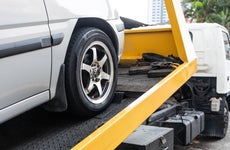Mistakes to avoid when leasing a car

The Bankrate promise
At Bankrate we strive to help you make smarter financial decisions. While we adhere to strict , this post may contain references to products from our partners. Here's an explanation for .
Key takeaways
- Leasing a vehicle carries positives, such as getting a new car every couple of years, along with negatives, like mileage restrictions and additional fees.
- Make sure you understand what happens when the lease ends, including what fees you'll owe and whether you can purchase the car.
- Mistakes to avoid when leasing a car include paying too much money upfront, underestimating mileage and not maintaining the car.
- Leasing companies may require higher liability insurance limits, so it's important to factor in potential insurance costs before signing a lease.
Leasing a car gives you a vehicle to drive for a fixed number of miles and months. In some ways it’s similar to renting an apartment instead of buying a house. The commitment is shorter, but you still have to pay for it. The monthly cost of leasing a car is often lower than buying it with an auto loan, with drivers saving an average of about $200 a month.
If you’ve decided that leasing instead of buying is the way to go, the steps are fairly straightforward. Like with buying a car, you’ll need to research ahead of time. Be ready to negotiate your terms going in, and know what mistakes are common so you can avoid them.
5 steps to leasing a car
While leasing is different from buying in many ways, there are still some similarities. Review these five steps ahead of time to make sure you’re fully prepared before you start shopping.
1. Do your research
You can lease just about any kind of car released in recent model years. You will want to narrow down the type and brand you are interested in first while factoring in how the price fits into your budget. To choose the right set of wheels, pay close attention to your driving habits and how well the vehicle matches your lifestyle.
When budgeting, prepare to pay a small amount before you drive off the lot to cover taxes and fees. More than that, if you want to lock in lower monthly payments throughout the lease, you can consider putting additional money down.
2. Visit dealers
Next on the list is to visit a few dealers and take some test drives. Doing so will help you narrow down what exactly you are looking for. You may want to call ahead and get an idea of what is available and whether test drives are currently allowed.
As you would for buying a car, consider the amount of space you’ll need on a regular basis and how much room you have to park the vehicle. It may be helpful to have another person with you to get a feel for how comfortable any regular passengers will be too.
3. Negotiate the terms of your lease
Pretty much every aspect of the lease agreement is up for negotiation, and the negotiation phase is the only chance you will have to get the perks you want in writing. To be the best negotiator, check current pricing on sites like Kelley Blue Book and remember to negotiate more than just price.
A good lease deal is one that will leave you paying as little over the lifetime of the loan as possible — initial down payment included. If negotiation intimidates you, bring a trusted friend to handle the hard conversation. Make sure to ask for the amount due when you sign the lease, this includes security deposit, title fees, capitalized cost reduction and monthly payments.
-
- Buyout price: The amount you’ll pay the dealer if you opt to purchase the vehicle when the lease ends.
- Disposition fee: This fee covers the dealer’s costs to prepare the vehicle for sale once it’s turned in.
- Gross capitalized cost: Also known as the vehicle’s sales price, this figure impacts the monthly payment and the buyout price.
- Mileage allowance: Leases come with a preset number of miles you’re allowed to drive annually, and failing to adhere to this cap means you’ll incur added fees unless you buy the vehicle when the lease ends.
- Money factor: The price you’ll pay to lease the vehicle — essentially, the interest rate.
4. Compare offers
Take advantage of online resources and compare the offers you have to get the best deal. Check out a few dealerships before signing off on your vehicle. Be mindful of the monthly cost, mileage cap, buyout price, money factor and capitalized vehicle cost.
Also, look at the fees the lessor is charging, including the acquisition fee, disposition fee and early termination fee, to gauge if it’s comparable to other similar offerings. And don’t forget to inquire about the amount due at signing.
5. Maintain the car throughout your lease
Remember that you must turn in the car at the end of the lease term. If it’s not in great condition, you might have to pay additional charges. Before leasing a car, ask about the guidelines on the lease-end condition. These guidelines specify the types of damage you would have to pay for before you return your car, known as the wear-and-tear assessment.
Mistakes to avoid
Leasing can lower your payments, but it can be very costly if you don’t pay attention to the fine print. Avoid these five common mistakes if you decide to lease your next vehicle.
Paying too much money upfront
Car dealers advertise low monthly lease payments on new vehicles, but you may have to pay several thousand dollars upfront to get that affordable payment. That money covers a portion of the lease in advance.
If the car is wrecked or stolen within the first few months, your insurance company will reimburse the leasing company for the value of the car, but the leasing company would likely not refund your down payment. You’d be out of a car, and that upfront money you handed over to the leasing company would essentially disappear.
It’s recommended you spend no more than about $2,000 upfront when you lease a car. In some cases, it may make sense to put nothing down and roll all of your fee costs into the monthly lease payment. If something happens to the vehicle before the end of the term, at least the leasing company doesn’t have a big chunk of your cash.
Not buying gap insurance
If you drive a leased car, you should pay for gap insurance. The “gap” refers to the difference between what you still owe on your lease and the car’s value.
Let’s say your contract states that at the end of the lease, you can buy the car for $13,000. If you crash and total the car before the lease expires, your insurance company will determine the car’s current market value and pay that amount to the dealership which owns the vehicle.
Suppose the insurance company says that the market value is only $9,000. In that case, you’ll probably have to pay $4,000 out of pocket to cover the difference between the lease contract’s residual value and the true market value — unless you have gap insurance. The gap coverage will cover the difference.
Many leases include gap insurance. The dealer may offer to sell you gap insurance, but you may find a cheaper policy option with a traditional insurance company. Regardless, the coverage is well worth the small investment.
Underestimating how many miles you’ll put on a car
To avoid extra charges, know your driving habits before leasing a car. Consider your daily commute and how often you take long trips. You could ask for a higher mileage limit if you know you’ll probably drive more miles than the agreement allows. However, that will likely increase your monthly payment because additional miles will result in greater depreciation.
It’s common for leasing contracts to have annual mileage limits of 10,000, 12,000 or 15,000 miles. If you exceed those mileage limits, you could be charged up to 30 cents per additional mile at the end of the lease.
Using 30 cents per mile as an example, if you exceed the mileage limit by 5,000 miles, you could end up owing an extra $1,500 when you turn the car in at the end of the lease.
Not maintaining the car
If your car has damage that goes beyond normal wear and tear, you could be on the hook for additional fees when it’s time to return it to the dealer.
If a car has a scratch but the mark is less than the width of the edge of a driver’s license or business card, many companies may consider it normal use and probably won’t charge a penalty. If the leasing company considers any damage excessive, it can charge additional fees.
The definition of normal use can vary from dealer to dealer. Your lessor will inspect the car before you turn it in and look for dents and scrapes on the body and wheels, damage to the windshield and windows, excessive wear on the tires and tears or stains in the interior upholstery. Don’t assume that your inspector will be lenient.
Leasing a car for too long
Make sure that the lease period either matches or is shorter than the car’s warranty period. Warranties vary from manufacturer to manufacturer, but they typically last up to three years or 36,000 miles, whichever comes first.
If you keep the car for longer than the warranty period, you may have to consider an extended warranty. Otherwise, you could be responsible for maintenance and repair costs for a car you don’t own while still making monthly lease payments.
If you plan to lease the vehicle for an extended period of time, it is likely best to just purchase the car. Make use of an auto lease versus purchase calculator to figure out whether leasing or buying a car will save you more money over the long term.
Not considering lease-specific insurance requirements
If you’ve ever financed a car, you may already know that most lenders require you to carry comprehensive and collision. If this is your first time insuring a leased vehicle, however, you might not be aware that you may also have to increase your liability limits.
The liability coverage portion of your auto policy pays for the other party’s medical expenses and property damage if you’re at fault in an accident. In addition to comprehensive and collision, most leasing companies require you to carry liability limits of at least $100,000 per person and $300,000 per accident for bodily injury, along with $50,000 for property damage. You may see this denoted as 100/300/50 on your policy documentation.
Depending on your current liability coverage, these limits may increase your car insurance premium — which may already be higher than you’re used to after adding your newly leased vehicle. To avoid surprises, you may want to get an insurance quote for the car you’re considering before signing on the dotted line.
Next steps
If leasing is right for you, do your homework, shop around and run the numbers to ensure that you get a lease that fits your driving habits and budget. Pay close attention to your monthly costs and the terms and conditions.
To calculate your monthly payment amount, the dealer will analyze the value of the new car versus its residual value. Like with any transaction involving financing, the higher your credit score, the lower your interest rate.
Related Articles



